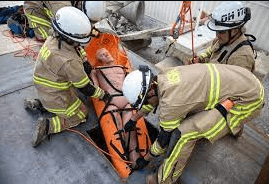Justify The Need For Fitness Evaluations For Those Wishing To Become Firefighters: A Detail Guide

Firefighting is one of the most demanding and dangerous professions in the world. It requires not only bravery but also physical fitness to be able to handle the rigors of the job. Firefighters are often called upon to perform strenuous activities like carrying heavy equipment, climbing ladders, and rescuing people from burning buildings. Given all these demands, it’s not surprising that fire departments require applicants to undergo fitness evaluations before they can become firefighters. Keep reading to justify the need for fitness evaluations for those wishing to become firefighters.
The Dangers of the Job
When fighting fires, firefighters are exposed to great risk and danger. These men and women put their lives on the line daily, often facing unpredictable conditions in hazardous environments.
Smoke inhalation can lead to serious respiratory problems that can compromise the health of firefighters. In addition to smoke inhalation, there’s also the risk of getting trapped in burning buildings or collapsing structures.
Exposure to extreme heat can cause burns, dehydration, and exhaustion. Firefighters must wear heavy gear that adds weight and restricts movement, making navigating through confined spaces difficult.
Furthermore, firefighting involves working with powerful equipment like hoses and axes; any misstep could result in life-threatening injuries or fatalities.
All these dangers make it crucial for firefighters to be brave and physically fit enough to face these challenges head-on. That’s why fitness evaluations are essential when determining who is qualified for this demanding job.
The Physical Demands of the Job
Being a firefighter is a challenging job. It requires courage, strength, and endurance to handle the challenges that come with it. One of these challenges is the physically demanding nature of the job. Firefighters are expected to carry heavy equipment and hoses while wearing gear weighing up to 75 pounds.
In addition, they have to climb ladders, break down doors, and move through smoke-filled buildings in search of victims or sources of fires. All these tasks require physical fitness beyond what’s needed for an average person.
If firefighters are not physically fit enough to perform their duties effectively, they could be at risk during emergencies. They must maintain their energy levels throughout long shifts without getting tired or exhausted.
Moreover, a lack of physical fitness can lead to injuries due to overexertion or inability to perform certain tasks properly. Injuries sustained on the job can take a toll on mental and physical health, making it important for firefighters always to stay healthy and fit.
Therefore, those wishing to become firefighters must undergo rigorous fitness evaluations before joining this profession to meet the demands of this challenging career path head-on!
The Importance of Fitness Evaluations
Fitness evaluations are an essential aspect of ensuring the safety of firefighters. When it comes to a profession that requires physical exertion, strength, and endurance, it’s crucial to ensure all firefighters meet specific fitness standards before entering the field. These evaluations serve as a way to assess an individual’s physical abilities and determine whether they can perform their duties without putting themselves or others at risk.
The evaluation process includes cardiovascular endurance, muscular strength, endurance, flexibility, and body composition measurements. These elements help create a comprehensive view of each candidate’s physical health status while identifying potential risks that may arise during the job.
Without these assessments in place, there is no guarantee that every firefighter will be able to respond effectively in high-pressure situations. The ability to carry heavy equipment up flights of stairs or easily navigate tight spaces is critical for firefighting personnel.
Moreover, fitness evaluations provide additional benefits beyond ensuring safety on the job site. It helps those participating in them develop healthy habits by identifying areas where improvements need addressing before starting their work as firefighters.
Read also: Discovering Hidden Gems And Memorable Moments On Catsillustrated Rupps Rafters
Fitness evaluations protect firefighters’ lives and those they serve daily. Without this practice becoming more widespread throughout fire departments worldwide makes no sense from either an occupational or public safety standpoint!
How Fitness Evaluations Help to Ensure Safety on the Job
These evaluations allow departments to ensure that all firefighters are physically capable of performing the demanding tasks required. In addition to helping individual firefighters stay safe, fitness evaluations also help to improve overall crew safety by identifying potential issues before they become problems.
For example, if many firefighters have difficulty completing certain aspects of a fitness evaluation, such as carrying heavy loads or climbing ladders, this could indicate areas where additional training is needed to prevent injuries. With this, fire departments can minimize risks and protect civilians and first responders better.
Conclusion
Fitness evaluations are critical to the firefighter selection process as they provide an objective measure of physical fitness essential for the demanding firefighting job. Through assessments, recruiters can identify those best suited to become successful firefighters and reduce injury risk through proper training. Ultimately, these evaluations ensure that only qualified candidates who are physically prepared to handle the rigorous demands of firefighting will be selected, keeping both personnel and citizens safe while promoting efficient operations in departments nationwide.








